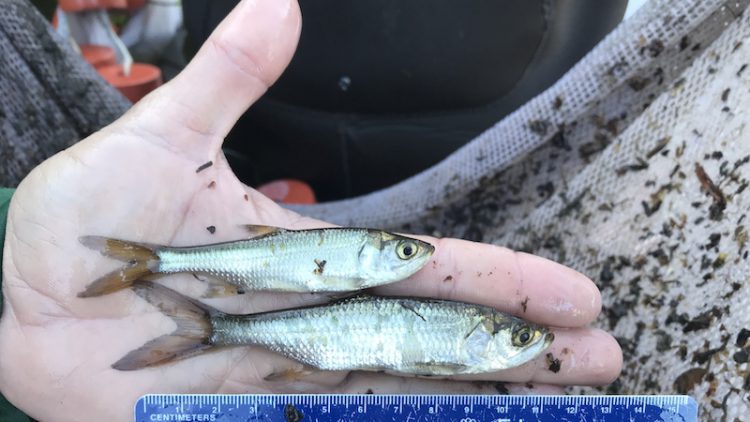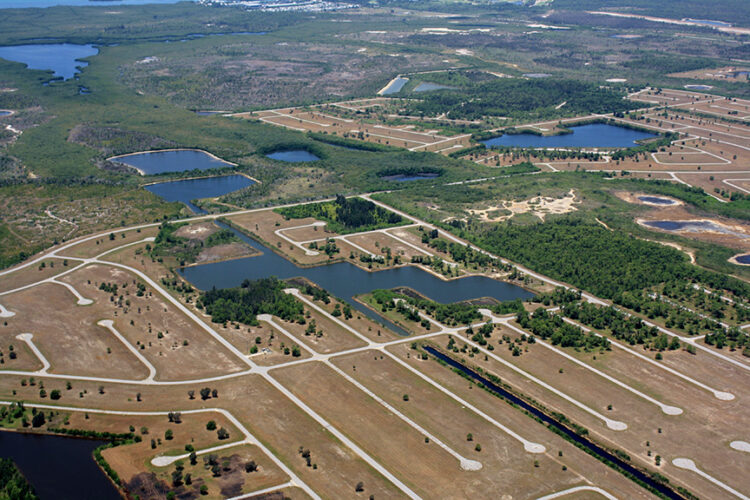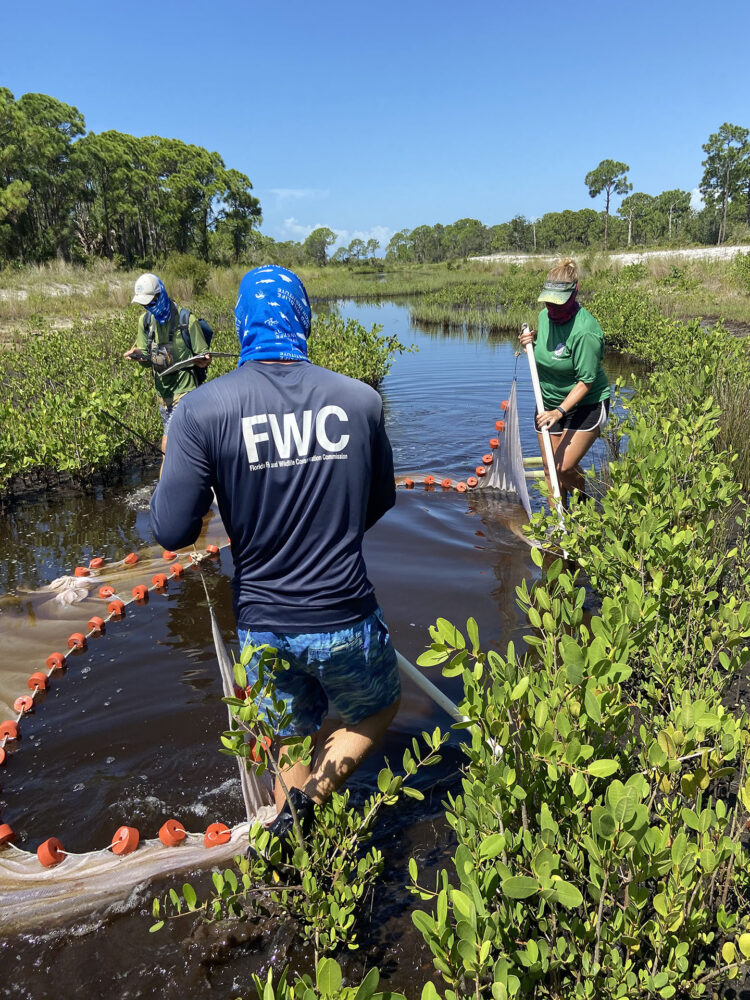By Miranda Madrid
On a sunny day out in Charlotte Harbor, a team of researchers catch adult fish and large juveniles as part of the Florida Fish and Wildlife Conservation Commission (FWC) Fish and Wildlife Research Institute (FWRI) fisheries-independent monitoring program. The researchers identify, count, and measure fish and invertebrates in an effort to inform how different species are managed.
The Charlotte Harbor team worked along the shorelines, pulling their nets over the seagrass beds in the hopes of finding the youngest sportfish.
“But we weren’t catching the small juvenile tarpon and snook, two of our main sportfish,” said Courtney Saari, a research administrator with FWC. Saari is now one of the three leaders of the monitoring program, which has operated for over 30 years, working in the major estuaries of Florida.

That was until an environmental specialist with the Charlotte Harbor Preserve State Park made a discovery in 2013.
“The park manager there saw juvenile tarpon and contacted one of the fisheries biologists for my program and was like, ‘Hey, I think we have marine fish up here. Can you come check them out, figure out what they are, how did they get here?’” Saari said. Sure enough, FWC and restoration partners sampled the area and found that the upper reaches of tidal creeks and ephemerally connected ponds in the park were nursery habitat for both tarpon and snook.
Then, another realization. “It was like, light bulb, this is where it is, way up in this crazy landscape. Then, uh oh, this landscape is starting to get developed,” said Corey Anderson, FWC habitat manager for two teams of biologists across north Florida. While some of these habitats were located within the state preserves, other nursery habitats were located beyond the protected land.
With the knowledge of where these youngest sportfish live and the urgency of urban development, FWC researchers were prompted to ask, what can be done to conserve this important habitat, and who is in charge of protection? Years after the initial discovery, Saari, who is the lead investigator of the project, and her team are collaborating to answer these questions as part of their $1.2 million project funded by the NOAA RESTORE Science Program in 2023.
Balancing Conservation with Development
Around the waterfront of Charlotte County are large areas of platted out land owned by thousands of individuals – roads run through these areas and lots wait to be built into residential properties. The nursery habitats are here, too. When the time is right, the juvenile sportfish can move out of the nursery through the tidal creeks and into the estuary to join the adult population. The coastal ponds and their connections to the estuary need protection.

The management of fisheries habitat has long been a passion for Saari, and that thread has continued with this project that focuses on both tarpon and snook. “I would say I’m more of a fisheries ecologist than a fisheries biologist. Studying habitat use has been a main theme in my career.”
Tarpon, a recreational sportfish prized for its strength and fighting spirit, is on the Charlotte County seal. Largely a retirement community, many residents enjoy the natural surroundings, recreational fishing and boating, and other aquatic activities.
“I was born and raised in Charlotte County where these projects are taking place,” said JoEllen Wilson, project partner and juvenile tarpon habitat program manager at Bonefish and Tarpon Trust (BTT). “It has so much more of a meaningful impact that we’re doing this in my backyard.”
BTT, formed in 1998, is a non-profit organization that prioritizes science-based conservation advocacy and outreach. BTT works with anglers and fishing guides to connect the experiences and knowledge of fishing communities to management and research. “They know way more than we could ever know about the fishery, so we team up with them. It’s a collaborative effort where they share what they’re seeing and we share the science,” Wilson said.
In Charlotte County, residents are concerned about the many impacts that coastal development can cause, especially to water quality.
“It was in 2020 during a town hall meeting with local and regional experts that it was recommended that there be some sort of centralized position created to coordinate and address water-related issues in the region,” said Brandon Moody, water quality manager for Charlotte County, who is the first hire for this recently created position.
Moody also serves as a conduit to the Charlotte County Board of County Commissioners, who are ultimately responsible for providing direction on local matters. He ensures that the project team has the commissioners’ support as they work on projects with a direct tie to Charlotte Harbor’s economy.
“It’s the commissioners’ perspective that as the water goes, so too does a significant chunk of our economy,” Moody said.
As more people move to Florida and build properties near the nursery habitat, taking action becomes more urgent. “If the county wants to work on conservation, or update their land use policies for enhanced stormwater management or sustainable development, that will also be sustainable for the ecosystem and now is the time to do it,” Saari said.
Planning a Collaboration
Early on, FWC researchers recognized that more could be done to protect these culturally and economically important sportfish, but they would need to work with individuals outside of their own agency. The planning for actionable science competition released by the NOAA RESTORE Science Program presented the opportunity to build out a formal collaboration.
“Planning actionable science was completely new to me,” said Anderson, lead investigator for the $114,058 planning project. “I did a lot of reading on collaborative research development and co-production publications right about that time.”
Anderson saw himself as an intermediary since his agency didn’t have decision-making authority over the nursery habitat in the to-be-developed land. He was motivated to lead the group to answer the question: “How do we get involved with habitat conservation when the legal authority for it is not seated within our agency?”

Even though co-production was a new concept to some, the researchers weren’t starting from scratch. Existing relationships with the Coastal & Heartland National Estuary Partnership (CHNEP) and local municipalities, managers, and scientists within the CHNEP’s ad hoc subcommittees provided them a chance to continue collaborating but in a new way.
The planning year consisted of four public workshops guided by a contracted facilitator. “We presented our conundrum that we’ve found these nursery habitats, backwater ponds that look unappealing to some people, but they’re super important to these fish. In the science world, we’ve published papers, but how do we get that data to the land-use planners and to the stormwater management folks?” Saari said.
Relevant agencies and end users in attendance helped define the management issue and provided their expertise to co-develop research and application plans.
With the final plans in hand, FWC received approvals from the CHNEP subcommittees and buy-in from the county commissioners. “Working through that whole planning process has been very rewarding. It’s been a heck of a lot of work,” Anderson said.
“We had some competing viewpoints as to what needs to be done, but it was helpful to have NGOs and state and county representatives in the room for more of a realistic perspective – to go from pie in the sky to what can we enact.”
– Courtney Saari, Project lead and FWC research administrator
Having dedicated funding and time to plan with managers and land-use planners gave the researchers perspective on how their research could be translated into something usable and useful.
“We had some competing viewpoints as to what needs to be done, but it was helpful to have NGOs and state and county representatives in the room for more of a realistic perspective – to go from pie in the sky to what can we enact,” Saari said.
Having Charlotte County play an advisory role in the planning was pivotal. Moody shared how the community development section of the county was able to shape the plans. “They can provide the information of, here’s the reality of what we as a local government can do, what we have the authority to do, where our limitations are, because the county doesn’t have carte blanche to do whatever it wants.”
Wilson agreed that developing a relationship with county officials was a major benefit of the project. “I think one of our most valuable partners coming into the workshop was having Charlotte County as a regional entity on board because that paved the way for what we’re doing for the 2023 actionable science grant.”
Elevating Habitat
The project team’s resulting research plan has four parts that will lead to the creation of decision-support tools for county and state governments. Shared conversations, expertise, and effort among FWC, BTT, Charlotte County, CHNEP, and others make their goals accomplishable as they conduct the research over the next four years.
First, BTT has a history of working with anglers and coastal residents to identify and characterize juvenile sportfish habitat and will continue to involve them. BTT and FWC will partner to identify natural habitats to protect and degraded habitats that should be a priority for restoration.
The project team will also work to assess and monitor a recently completed restoration project. This post-restoration monitoring will inform FWC’s decision of where to site and how to design a restoration project that will be incorporated into the state’s restoration plans.
Hydrologic modeling outputs will also inform these future decisions.
“That’s really what came out of the workshops was that it can’t just be a map of ponds with fish in them. It needs to have more than that. It needs to incorporate development scenarios and different drainage patterns,” Saari said. With this feedback, hydrologic modeling will take coastal development and stormwater drainage into account.

Finally, the team will use a habitat evolution model to understand sea level rise impacts within the study area.
“This is an opportunity to better understand landscape and flow dynamics in that area,” Moody said. “This is going to be one of those parts of the county that are going to start seeing the impacts of sea level rise sooner than others.”
The ultimate goal is to create a map-based habitat vulnerability index using the modeling outputs, along with the locations of sportfish nursery habitat. This index will inform an overlay district, which is a land-use planning tool that includes specific considerations for an area’s development.
This created overlay district, or GIS-layer, can be integrated into a mapping tool that the county land-use planners already use to regulate or incentivize habitat protection. This product can inform conservation amendments that could be enacted to preserve sportfish nursery habitat in the county’s 2028 Comprehensive Management Plan update as decided by the county commissioners.
For both management entities, FWC and Charlotte County, the planning and research is shifting their attention to a habitat conservation model.
“We’ve changed our fisheries management scheme for a lot of these inshore fish species,” Anderson said. “We’re incorporating environmental variables and habitat-driven aspects and things like harmful algal blooms in our regulations.” He recognizes that working with those with more authority over water quality and land-use development will make their impact go further.
“It’s been decades in the making getting to this point where our state fisheries management agency is trying to introduce habitat into their fisheries management plans. And now our county planning is accounting for sportfish,” Wilson said. “If Florida and Charlotte County, specifically, starts investing in its natural resources, its water quality and its fisheries, that’s going to set a huge precedent for other counties to start following suit.”
Cover image: A tarpon fish with mangroves in the background. Photo credit: FWC
 Official websites use.gov
A .gov website belongs to an official government organization in the United States.
Official websites use.gov
A .gov website belongs to an official government organization in the United States.
 Secure .gov websites use HTTPS
A lock or https:// means you’ve safely connected to the .gov website. Share sensitive information only on official, secure websites.
Secure .gov websites use HTTPS
A lock or https:// means you’ve safely connected to the .gov website. Share sensitive information only on official, secure websites.